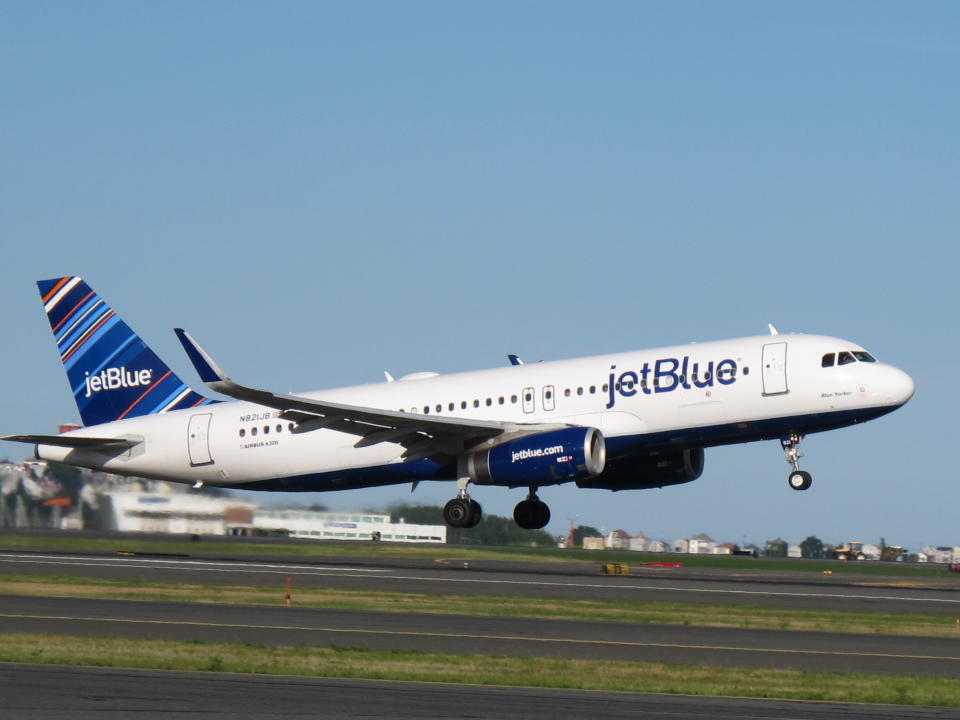JetBlue Airways Earnings Sagged Last Quarter
After reporting phenomenal earnings growth in 2015 and the first half of 2016, JetBlue Airways (NASDAQ: JBLU) has experienced steady margin erosion. Over the past three years or so, rising fuel prices, nonfuel cost inflation, and erratic demand trends have combined to undo some of the earnings gains JetBlue achieved a few years ago.
This trend continued in the first quarter of 2019, as JetBlue reported a year-over-year decline in unit revenue and a sharp drop in its earnings. Let's take a look at the company's results -- and why management is confident that the worst is over.
JetBlue Airways results: The raw numbers
Metric | Q1 2019 | Q1 2018 | Year-Over-Year Change |
|---|---|---|---|
Revenue | $1.87 billion | $1.75 billion | 6.7% |
Total unit revenue | 12.12 cents | 12.5 cents | (3.1%) |
Cost per available seat mile excluding fuel and special items | 8.66 cents | 8.58 cents | 0.9% |
Adjusted net income | $51 million | $83 million | (38%) |
Adjusted pre-tax margin | 3.7% | 6.4% | N/A |
Adjusted earnings per share | $0.16 | $0.26 | (38%) |
Data source: JetBlue Airways Q1 earnings release.
What happened with JetBlue Airways this quarter?
Three months ago, JetBlue reported stellar earnings growth for the fourth quarter of 2018, driven by a 2.4% increase in revenue per available seat mile (RASM). Management projected similar underlying trends for the first quarter, but noted that RASM might decline by as much as 2%, due to holiday timing and the absence of winter storms that boosted unit revenue in early 2018.
However, JetBlue was one of several airlines forced to reduce its forecast last month. Weak last-minute fares on transcontinental routes and a dip in demand for off-peak travel were the main drivers of this guidance revision. A higher-than-expected completion factor (i.e., unusually low number of flight cancellations) also weighed on unit revenue last quarter. Ultimately, RASM dropped 3.1% year over year.
JetBlue grew its capacity 10.1% last quarter, so revenue rose 6.7% despite this RASM decline. Additionally, JetBlue held unit costs roughly flat last quarter, with a slight dip in fuel prices offsetting modest nonfuel unit cost growth of 0.9% (which was better than the company's guidance). This helped minimize the impact of JetBlue's RASM decline on its profitability.
After the end of the quarter, JetBlue confirmed what many pundits had long anticipated: It plans to begin flying to London from Boston and New York in 2021. To facilitate this service, JetBlue has converted 13 A321neo orders to the long-range A321LR model. The goal is to better serve business travelers in its top two focus cities. JetBlue is likely to add other cities in Europe to its route map after the London routes begin.
What management had to say
JetBlue's earnings results fell short of management's initial expectations last quarter and its profit margin tumbled. Nevertheless, CEO Robin Hayes tried to put a brighter spin on the airline's performance, predicting better times ahead:
In recent years we have repeatedly demonstrated our ability to adapt to the changing environment around us to achieve our margin commitments -- and 2019 is proving to be no different. We believe we will successfully execute our five "building blocks" introduced at our 2018 Investor Day, and we remain committed to our goal of delivering earnings per share between $2.50 and [$3.00] by 2020. We also continue to expect margin expansion in 2019, and to further expand our margins in 2020.
CFO Steve Priest also highlighted JetBlue's strong first-quarter cost performance. "Our first quarter CASM ex-fuel [cost per available seat mile excluding fuel] represents a unit cost increase below the mid-point of our guidance range. ... We are encouraged by the CASM ex-fuel progress we made in the first quarter, and the progression we anticipate for the rest of the year."
Looking forward
For the second quarter, JetBlue expects a 2.25-percentage-point RASM benefit from the timing of Easter and Passover, offsetting the RASM headwind it experienced last quarter. And while unit revenue trends were weak in the first half of April, management is cautiously optimistic for the rest of the quarter, based on the early booking trends for May and June.

JetBlue expects RASM growth to strengthen in the next few months. Image source: JetBlue Airways.
As a result, JetBlue currently projects that RASM will increase 1% to 4% year over year this quarter. Meanwhile, it expects a 1.5% to 3.5% boost in nonfuel unit costs -- driven entirely by a pilot contract implemented last August -- and another modest year-over-year decline in fuel prices.
This forecast would be consistent with a wide range of outcomes in terms of earnings growth for the second quarter. However, based on the midpoint of the guidance, JetBlue would deliver solid revenue growth and margin expansion, leading to double-digit earnings growth.
Looking beyond the upcoming quarter, JetBlue expects trends to improve further. The headwind from JetBlue's new pilot contract will disappear in the second half of the year, while a variety of cost reduction efforts will continue to pay off. Meanwhile, stronger seasonal demand over the summer, route changes, and the planned implementation of a "basic economy" fare option later this year should bolster RASM growth. Still, given the recent volatility in JetBlue's results, investors will want to keep a close eye on the company's progress toward its ambitious goals.
More From The Motley Fool
Adam Levine-Weinberg owns shares of JetBlue Airways. The Motley Fool recommends JetBlue Airways. The Motley Fool has a disclosure policy.

